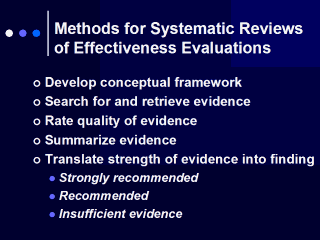| front |1 |2 |3 |4 |5 |6 |7 |8 |9 |10 |11 |12 |13 |14 |15 |16 |17 |18 |19 |20 |21 |22 |23 |24 |25 |26 |27 |review |
 |
So how
does the Task Force develop its findings? First, the systematic review development team determines the causal chains and outcomes related to the topic under review. The team then determines what part of this framework they are going to focus their review on (for the tobacco review this was prevention and control, as opposed to just prevention of initiation). Then classes of interventions are refined (for tobacco, those designed to prevent initiation, increase cessation, and prevent exposure to environmental tobacco smoke). Second, search terms are developed and a comprehensive literature review is conducted to find all the possible studies on the effectiveness of the selected interventions (for tobacco this turned up just over 16,000 citations). The third step is rating the quality of the evidence and the studies looking at the quality of study design, study execution, and reported effect measures (for tobacco this meant comprehensively abstracting over 1,000 studies) Next is summarizing the evidence of effectiveness: looking across the evidence, what can be concluded? Interventions with the strongest evidence of effectiveness are strongly recommended, those with sufficient evidence are recommended, and those for which available studies do not provide sufficient evidence to assess effectiveness are categorized as having insufficient evidence (which doesn’t mean the intervention does not work, it just means that additional studies are needed to asses its effectiveness). While negative findings often more difficult to find, the Task Force will issue a finding discouraging use of a intervention where there is sufficient or strong evidence of ineffectiveness or harm. |